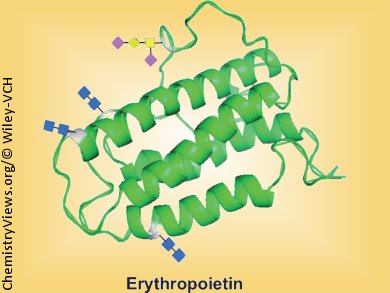Erythropoietin: Red Blood Cell Producer
“Blood is quite a peculiar kind of juice“—that is what Mephisto knew, according to Goethe’s “Faust“. But if blood really is very special, then erythropoietin (EPO) must be a very special molecule, as it triggers the production of our red blood cells. After ten years of intense research, American scientists have now succeeded in making a fully synthetic version of this special molecule. This achievement represents a landmark advance in the chemical synthesis of complex biological molecules from basic building blocks.
EPO is a hormone produced in the kidneys that induces the differentiation of bone marrow stem cells to erythrocytes (red blood cells). Upon sensing decreased oxygen in circulation, EPO is secreted to boost the production of red blood cells. EPO has found many therapeutic applications. Dialysis patients, whose haematosis is affected by renal failure, are treated with EPO and the drug is also given to cancer patients who have undergone chemotherapy or radiation therapy. Black sheep among racing cyclists, and other athletes, have abused EPO in an effort to improve their athletic performance.
Fully Synthetic Erythropoietin
Until now, only nature itself was able to synthesize EPO. For therapeutic use, the drug has to be produced biotechnologically in cell cultures. In a major breakthrough, a team led by Samuel J. Danishefsky at the Sloan-Kettering Institute for Cancer Research in New York, USA, has now produced a fully synthetic EPO by total synthesis in their lab. Because classical methods of protein synthesis were insufficient to build up this complex biomolecule, the scientists had to develop sophisticated new synthesis strategies to attain their objective.
EPO is not actually one compound but a large family of molecules. Known as glycoproteins, the structures are composed of a protein decorated with four carbohydrate sectors. The protein portion is always the same, as are the locations at which the carbohydrate domains are attached. Yet, in endogenous EPO protein, there are a wide variety of different carbohydrate sectors that may be appended to the protein. It has not been possible to access naturally occurring EPO as a homogeneous, pure molecule. By adopting the tools of chemical synthesis, the investigators were able to make, for the first time, pure “wild type” EPO glycoprotein incorporating the natural amino acid sequence and four carbohydrate sectors of strictly defined structure. Extension of this strategy will enable scientists to make numerous versions of the molecule and to study how differences in the chemical structure of the carbohydrate domains may affect how the glycoprotein induces the production of red blood cells.
The structure of the synthetic EPO was verified by mass spectrometry. Tests using stem cells proved the effectiveness of the synthesized EPO: like its natural counterpart, the synthetic EPO triggered the formation of red blood cells from stem cells.
- At Last: Erythropoietin as a Single Glycoform,
Ping Wang, Suwei Dong, John A. Brailsford, Karthik Iyer, Steven D. Townsend, Qiang Zhang, Ronald C. Hendrickson, JaeHung Shieh, Malcolm A. S. Moore, Samuel J. Danishefsky,
Angew. Chem. Int. Ed. 2012.
DOI: 10.1002/anie.201206090




